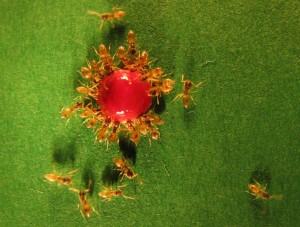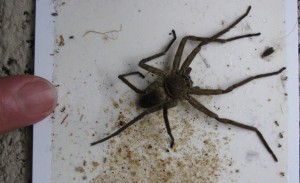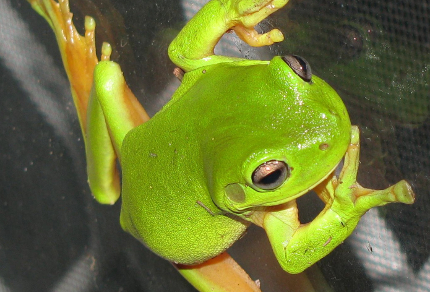When I awoke and heard rain pouring down outdoors, I couldn’t bear the thought of running drenched in the darkness this morning. I especially couldn’t bear the thought of sodden shoes and clothes clinging to me and again bringing on blisters on my toes and runner’s rash on my inner thighs.
Hoping for better weather later, I groggily made my way into the kitchen and spotted the biggest spider I’ve ever seen outside a zoo. It rested motionless on the floor near a cockroach trap Vilis had set at the base of a cupboard. The spider was about 10 centimetres long, brown, with very long legs, a thin coat of hairs, and eight eyes in two rows of four. Not having a clue what species it was, I nervously attempted to shoo it into a large plastic container so I could relocate it outdoors. On my approach, it scurried into the nearest shelter, which unfortunately was the cockroach trap, where the spider stuck to the tacky surface. I carried it outdoors, and later Vilis dispatched it, since he wasn’t able to free it. I checked out Australian spiders on the web, but wasn’t able to positively it, so Vilis said he would ask about it at JCU.

Tiny Ants on Strawberry Jam (© Vilis Nams)
This spider episode prompted me to review our domestic wildlife situation. Within five days of moving into this house, we had tiny brown ants scouting out the place. They now focus on patrolling the kitchen counter holding the sink, but show up anywhere in the house, including on my laptop screen or the rim of my cup after I’ve eaten something sweet. They haven’t been crawling over me, and as long as we don’t leave food out and do clean up immediately after meals, we manage to keep them under control.

Cockroach (©Vilis Nams)
Daddy longlegs and tiny window spiders hang out regularly inside, and we’ve had four cockroaches, one of which was a dead one being carried upside down across the kitchen floor by a horde of tiny ants that looked like miniscule pallbearers. We haven’t caught a single cockroach in the cockroach trap, and they’re so fast that one eluded Vilis in the living room and seemed to simply disappear into thin air.
Two geckos and a very small frog also made brief appearances indoors and were either shooed out or disappeared on their own. And then, of course, there was today’s spider, which was the most unsettling of our encounters to date.

Big Spider (© Vilis Nams)
Speaking of unsettling encounters,we learned this week that golfers at Townsville’s Willows Golf Resort have been sharing the greens with a 2-metre freshwater crocodile that had laid claim to a waterhole near the 17th hole.1 And today, a saltwater croc showed up on The Strand, causing the ocean-front park to be shut down until the big reptile could be captured and transported elsewhere.2 Flooding caused by heavy rains encourages both kinds of crocs to move farther inland, and they are sometimes stranded when waters recede.1
Crocodiles, of course, have a certain muscular, jaw-snapping mystic that raises them to a significantly higher level than other species of invading wildlife. Although the world has 13 species of crocodiles, Australia is home to only 2. The freshwater crocodile or Johnstone’s crocodile grows to 2 or 3 metres in length, has a narrow snout it can move quickly in the water to catch fish and other swift-moving aquatic life, and lives in freshwater rivers and billabongs3 (and, apparently, golf course water holes). It occurs only in northern Australia, in a band stretching from northern Western Australia to north-central Queensland.3 This crocodile isn’t normally considered dangerous to people, but a few swimmers have been injured in encounters, perhaps when flailing limbs were mistaken for prey.3
The saltwater or estuarine crocodile is an entirely different story. It’s the largest living crocodile species and, although normally 3 to 5 metres in length, can grow to 7 metres.3 Saltwater crocs live in coastal rivers and swamps along the top of Australia, from the northern tip of Western Australia to southeastern Queensland.3 They also inhabit inland portions of major river systems that drain into the ocean along the north coast.3 Primarily nocturnal hunters, they often spend their days basking in the sun on shore.3 They have broad snouts that they use to grab big, strong prey like cattle and kangaroos and people.3
While still in Canada, I retrieved a list of ‘Be croc wise’ information from the Queensland government, which essentially said to never swim where crocodiles may occur, stay back from the water edge in crocodile country (no washing hands in the river, no preparing food or cleaning dishes on the bank), and camp at least 2 metres above high water level and 50 metres away from the shore, taking care to not leave food scraps around camp.4 In Canada, we did our wilderness camping with bears in mind; in Australia, we’ll do it with crocodiles in mind.

Green Tree Frog (© Vilils Nams)
Beyond the house walls, our yard is well-used by urban wildlife. When the sun shines, numerous butterflies and birds flit through it. When the rain pours, frogs rasp and croak their songs. Skinks race over rocks and up and down tree trunks, and geckos decorate the exteriors of our windows during the dark hours while they hunt moths. One evening, we came home to find a brilliant green tree frog sitting on the cement patio, and this evening, such a frog climbed onto the exterior of the kitchen window. With its legs splayed over the glass, we were able to see its red leg linings and white belly, as well as its clinging toe pads. I learned from Gerry Swan’s Green Guide Frogs of Australia that green tree frogs often live around humans and have a preference for mailboxes, bathrooms, and toilets.5 Just imagine flushing, only to spot a big, bright green frog swimming in the swirling water within the toilet bowl!
References:
1. Rachel Toune. Crocodiles par for this course. Townsville Bulletin, February 19, 2010. The North Queensland Newspapers Company Pty Ltd © January 2007. Accessed 23-Nov-2010. http://www.townsvillebulletin.com.au/article/2010/02/19/116565_news.html
2. Josh Bavas. Croc spotted on Townsville’s Strand. ABC News, February 17, 2010, 7:12 p.m. Accessed 23-Nov-2010. http://www.abc.net.au/news/stories/2010/02/17/2822775.htm
3. Steve Wilson and Gerry Swan. A Complete Guide to Reptiles of Australia. 2008. New Holland Publishers (Australia) Pty Ltd, Sydney, p. 22.
4. Queensland Government, Environmental Protection Agency. Crocodiles – Be croc wise. Updated 29 October 2008. Accessed Nov-2009. http://www.derm.qld.gov.au/wildlife-ecosystems/wildlife/living_with_wildlife/crocodiles/crocodiles__be_croc_wise.html
5. Gerry Swan. Green Guide Frogs of Australia. 2001. New Holland Publishers (Australia) Pty Ltd, Sydney, p. 19.


